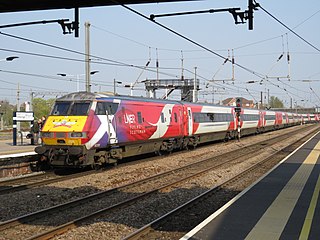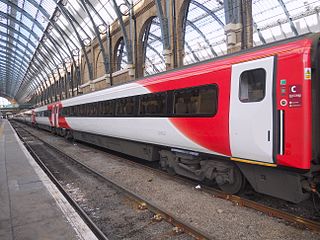This article needs additional citations for verification .(January 2018) |


A Restaurant Standard Buffet (RSB) is a type of rail passenger car that operates on railway lines within the United Kingdom.
This article needs additional citations for verification .(January 2018) |


A Restaurant Standard Buffet (RSB) is a type of rail passenger car that operates on railway lines within the United Kingdom.
The British Rail Mark 4 converted coaches comprise 30 standard class seats placed round tables in an airline style formation. They were manufactured as Restaurant First Buffets by Metro-Cammell, Washwood Heath as part of the InterCity 225 sets for use on the East Coast Main Line. [1] [2] When refurbished by GNER as part of its Project Mallard in the mid-2000s, the first class seating was replaced by standard class seating and they thus became Restaurant Standard Buffets. [3]
There are no plug sockets at these seats due to the high power usage of the catering equipment in the coach. The buffet counter is equipped with a coffee machine, panini toaster, and a large fixed fridge.
The coaches were originally built to provide on board catering and crew accommodation. The kitchen was equipped with 2 fan ovens, 2 removable refrigerators, a 4 ring hob, extractor fan system, microwave, dishwasher, panini (sandwich) toaster, hot water still and water steriliser.
Originally operated by InterCity, all passed to successive InterCity East Coast franchisees GNER, National Express East Coast, East Coast, Virgin Trains East Coast and London North Eastern Railway. Withdrawals commenced in 2019 as the Class 801s entered service. Some are now operated Transport for Wales Rail. [4]

First class is the most luxurious and most expensive travel class of seats and service on a train, passenger ship, airplane, bus, or other system of transport. Compared to business class and economy class, it offers the best service and most comfortable accommodation.

Great North Eastern Railway, often referred to as GNER, was a train operating company in the United Kingdom, owned by Sea Containers, that operated the InterCity East Coast franchise on the East Coast Main Line between London, Yorkshire, North East England and Scotland from April 1996 until December 2007.

The InterCity 125 (originally Inter-City 125) or High Speed Train (HST) is a diesel-powered high-speed passenger train built by British Rail Engineering Limited between 1975 and 1982. A total of 95 sets were produced, each comprising two Class 43 power cars, one at each end, and a rake of seven or eight Mark 3 coaches. The name is derived from its top operational speed of 125 mph (201 km/h). At times, the sets have been classified as British Rail Classes 253, 254 and 255.

InterCity was introduced by British Rail in 1966 as a brand-name for its long-haul express passenger services.

A Driving Van Trailer (DVT) is a British purpose-built control car railway vehicle that allows the driver to operate with a locomotive in push-pull formation from the opposite end of a train. A key benefit of operating trains with DVTs is the requirement for fewer locomotives; for example, a second locomotive would otherwise have to join at the other end of the train after arrival at terminal stations to lead the train's onward journey.

The InterCity 225 is an electric high speed train in the United Kingdom, comprising a Class 91 electric locomotive, nine Mark 4 coaches and a Driving Van Trailer (DVT). The Class 91 locomotives were built by British Rail Engineering Limited's Crewe Works as a spin-off from the Advanced Passenger Train project, which was abandoned during the 1980s, whilst the coaches and DVT were constructed by Metro-Cammell in Birmingham and Breda in Italy, again borrowing heavily from the Advanced Passenger Train. The trains were designed to operate at up to 140 mph (225 km/h) in regular service, but are limited to 125 mph (200 km/h) principally due to a lack of cab signalling and the limitations of the current overhead line equipment. They were introduced into service between 1989 and 1991 for intercity services on the East Coast Main Line (ECML) from London King's Cross to Leeds, York and Edinburgh.

The British Rail TC multiple units were unpowered fixed formations of 3 or 4 carriages with a driving position at each end of the set, converted by BR's Holgate Road carriage works from locomotive-hauled Mark 1 carriages in 1966–1967 and 1974. The units built on experience gained from the prototype 6TC unit. In time the 3 car units were reformed into four car units to match the rest of the fleet and later classified as Class 442. This was later changed to Class 491, under which they spent the majority of their working lives. Shortly before withdrawal they were reclassified Class 438 and the units were renumbered to 8001-8034.

The Mark 2 family of railway carriages are British Rail's second design of carriages. They were built by British Rail workshops between 1964 and 1975. They were of steel construction.

The British Rail Mark 3 is a type of passenger carriage developed in response to growing competition from airlines and the car in the 1970s. A variant of the Mark 3 became the rolling stock for the High Speed Train (HST).

The British Rail Mark 4 is a class of passenger carriages built for use in InterCity 225 sets on the East Coast Main Line between King's Cross, Leeds and Edinburgh. Withdrawals began in 2019, with some being sold for further use with Transport for Wales between Cardiff and Holyhead.
A wide variety of hauled coaches have been used on the railways of Ireland. This page lists all those since 1945.

The British Rail Class 91 is a high-speed electric locomotive, which produces power of 4,830 kW (6,480 hp); it was ordered as a component of the East Coast Main Line modernisation and electrification programme of the late 1980s. The Class 91s were given the auxiliary name of InterCity 225 to indicate their envisaged top speed of 225 km/h (140 mph); they were also referred to as Electras by British Rail during their development and throughout the electrification of the East Coast Main Line.

The British Rail Class 90 electric locomotives were built for mixed-traffic duties, operating from 25 kV AC overhead lines and producing 5,000 bhp (3,700 kW). They weigh 84.5 tonnes and can typically achieve a top speed of 110 mph (177 km/h).

National Express East Coast (NXEC) was a train operating company in the United Kingdom, owned by National Express, that operated the InterCity East Coast franchise on the East Coast Main Line between London, Yorkshire, North East England and Scotland from December 2007 until November 2009.

A First Open or FO, is a type of railway carriage used by British Rail and subsequent operators since privatisation. They were first produced as British Railways Mark 1, and subsequently Mark 2, Mark 3, and Mark 4 variants were produced. This type of carriage is an "open coach" because of the arrangement of the seats inside – other types of carriage may be corridor based variants (FK) or have a brake compartment.

The British Rail Mark 5 is the designation given to the planned passenger rolling stock for the InterCity 250 project, a plan to improve speeds on the West Coast Main Line that was ultimately cancelled.

East Coast, the trading name of the East Coast Main Line Company, was a British train operating company running the InterCity East Coast franchise on the East Coast Main Line between London, Yorkshire, North East England, and Scotland. East Coast ran long-distance inter-city services from its Central London terminus at London King's Cross on two primary routes; the first to Leeds and the second to Edinburgh via Newcastle with other services reaching into Yorkshire and Northern and Central Scotland. It commenced operations on 14 November 2009 and ceased on 28 February 2015.

InterCity East Coast is a railway franchise for passenger trains on the East Coast Main Line in the United Kingdom from London King's Cross to Hull, Leeds, Bradford, Harrogate, Newcastle, Edinburgh, Glasgow, Inverness and Aberdeen. It was formed during the privatisation of British Rail and transferred to the private sector in April 1996.

The CAF Mark 4 are railway carriages operated by Iarnród Éireann in Ireland on the InterCity service from Dublin to Cork. These carriages have no connection to the British Rail Mark 4.

The RUB type carriage stock was a type of steel bodied air conditioned passenger carriage operated by the New South Wales Government Railways from September 1949 until April 2000.